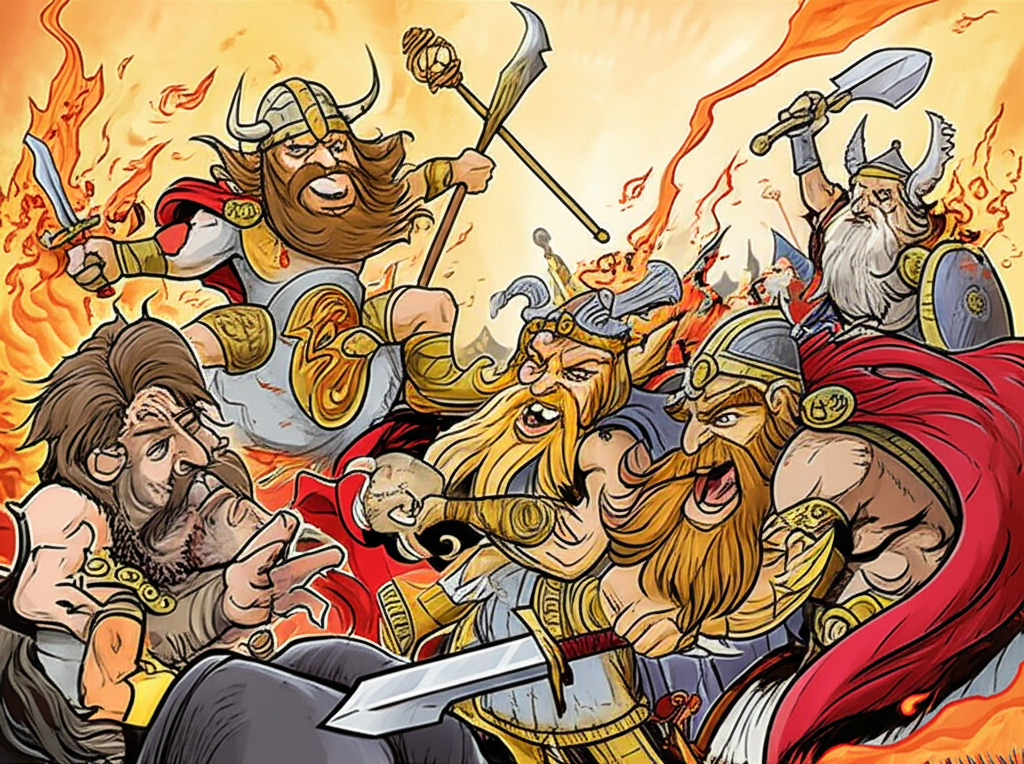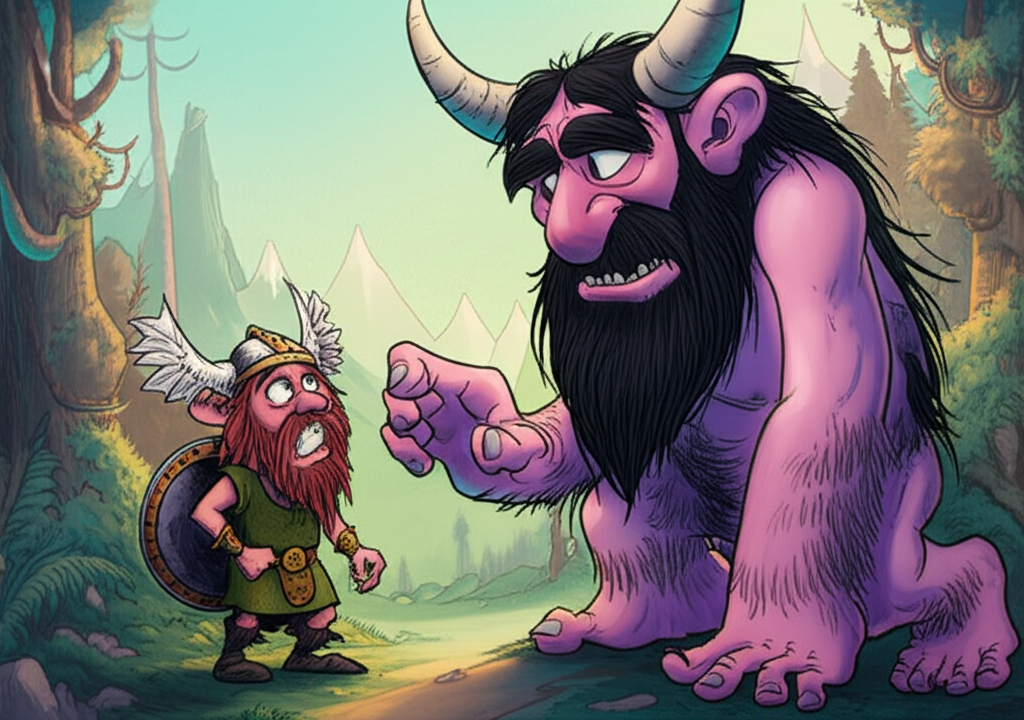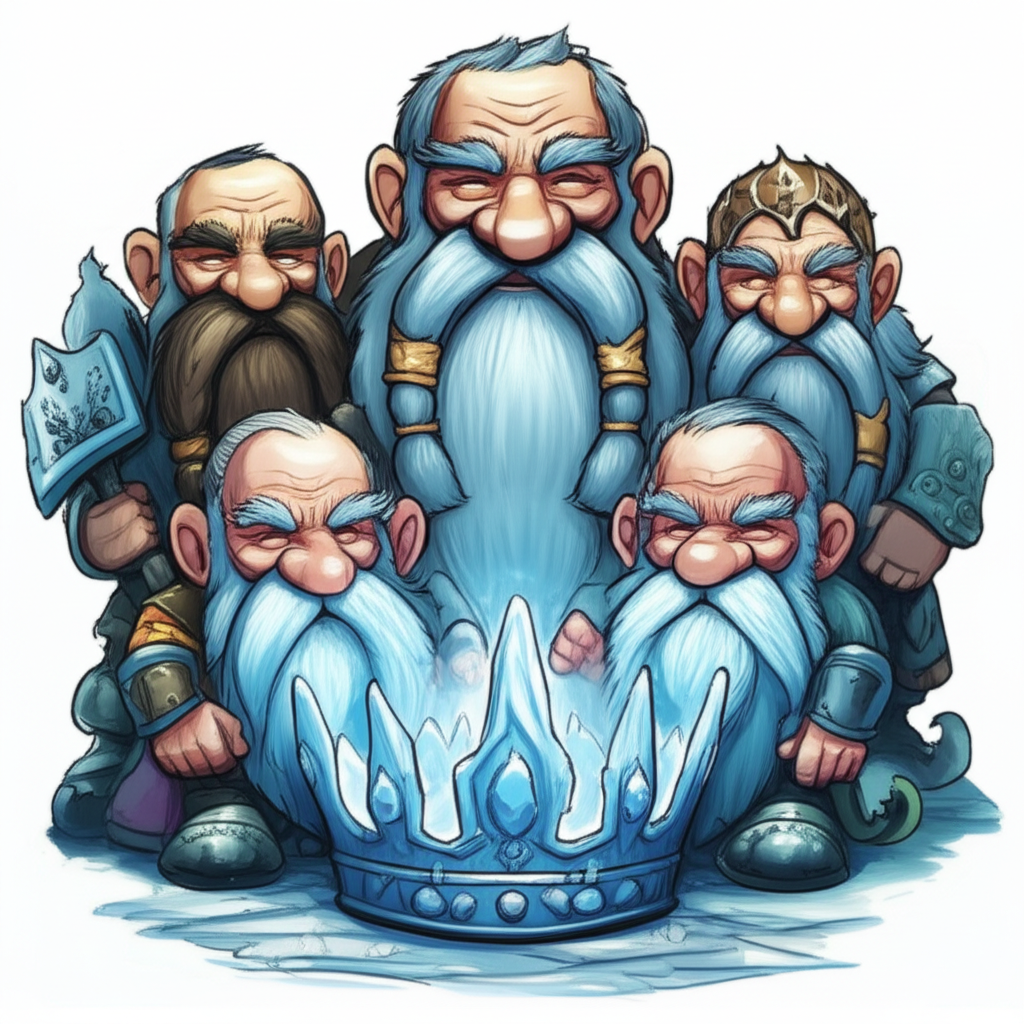
The tapestry of human imagination is woven with threads of ancient stories, tales passed down through generations, offering glimpses into the worldview of those who came before us. Among the most vivid of these are the myths and legends of the Norse people, inhabitants of the rugged, often harsh lands of Scandinavia. These were people who lived amidst towering fjords, dense forests, and the relentless power of the elements. Their stories, born from this environment, often reflected a profound respect for nature’s untamed forces and a deep understanding of the constant struggle between order and chaos, creation and destruction.
One such foundational narrative, crucial to understanding the Norse cosmos, is the tale of the Aesir-Vanir War and its connection to the origins of Muspelheim, the realm of primal fire. This is not a historical account, but rather a rich, symbolic story told by ancient peoples to explain the fundamental forces they perceived shaping their world.
A World Forged in Ice and Fire: Origins and Cultural Background
The myths of the Norse gods, the Aesir and the Vanir, emerged from a society that was deeply intertwined with the natural world. The Viking Age, a period of significant Norse expansion and influence, spanned roughly from the late 8th to the mid-11th century CE. During this time, Norse society was characterized by seafaring, trade, and a warrior ethos. Life was often precarious, dictated by the seasons, the bounty of the land and sea, and the ever-present threat of conflict, both human and, in their understanding, supernatural.
These ancient peoples viewed the world as a dynamic and often volatile place. They saw cosmic forces at play, personified by gods and other mythical beings, who governed everything from the harvest and fertility (represented by the Vanir) to warfare, wisdom, and the ruling of the cosmos (represented by the Aesir). Their worldview was not one of simple dualities but a complex interplay of powers, where creation and destruction were inextricably linked. The concept of wyrd, or fate, was also central, suggesting that even the gods were subject to a larger, overarching destiny. It was within this framework of a dynamic, sometimes perilous, cosmos that stories like the Aesir-Vanir War and the fiery origins of Muspelheim were conceived and shared, often around crackling hearths during long, dark winters.
The Primal Flame: Muspelheim and its Inhabitants
At the heart of the fiery narrative lies Muspelheim, a realm often described as a place of searing heat and eternal flame. It is not a place of comfort or solace, but rather the embodiment of pure, unbridled fire. Within this domain resided the beings who were born of its heat and fury.
The most prominent figure associated with Muspelheim is Surtr. He is not depicted as a god in the same vein as the Aesir or Vanir, but rather as a primordial giant, a being of immense power whose very existence is tied to the elemental force of fire. Surtr is often described as wielding a flaming sword, a symbol of destruction and the ultimate end of all things. His physical appearance, when described, emphasizes his fiery nature: a towering figure with eyes like burning coals and a beard of flame. He represents the destructive potential inherent in the universe, the force that can consume and transform all that exists. His symbolic attribute is the raw, untamable power of fire itself – a force of creation in its ability to forge and refine, but more dominantly, a force of annihilation.
The Clash of Powers: A Narrative of Cosmic Birth
The traditional accounts of the Aesir-Vanir War, as preserved in the Poetic Edda and Prose Edda, do not explicitly detail the creation of Muspelheim as a direct consequence of the war. Instead, Muspelheim is presented as an existing, primordial realm, a fundamental aspect of the Norse cosmos from its earliest stages. However, the conflict between the Aesir and the Vanir serves as a pivotal event that shapes the relationships between the divine realms and underscores the inherent tensions within the Norse pantheon, tensions that, in a broader sense, relate to the balance between creation and destruction that Muspelheim embodies.
According to these ancient tales, the Aesir and the Vanir were initially two distinct groups of gods, each with their own domains and characteristics. The Aesir, residing in Asgard, were largely associated with power, war, wisdom, and order. The Vanir, dwelling in Vanaheimr, were primarily linked to fertility, prosperity, magic, and the natural world.
The war, as it is recounted, began with an act of aggression or mistrust between the two factions. The exact cause is debated and sometimes contradictory within the sources, but a common thread is that the Aesir initiated hostilities, perhaps out of fear or a desire to assert dominance. This led to a prolonged and devastating conflict that shook the very foundations of the cosmos. Both sides wielded immense power, and the battles were fierce, resulting in significant casualties.
As the war raged, it became clear that neither side could achieve a decisive victory. The destructive nature of the conflict threatened to unravel the established order. In a moment of realization and a desire for peace and reconciliation, the Aesir and Vanir eventually agreed to a truce. As a symbol of this newfound unity and to ensure a lasting peace, a remarkable exchange took place: hostages were sent to each other’s realms.
Among the prominent figures who were exchanged were Njord, a god of the sea and wealth, and his children, Freyr and Freya, gods of fertility and love, who went to live among the Aesir in Asgard. In return, Mimir, a wise giant known for his counsel, and Hoenir, a skilled warrior, were sent to the Vanir. This exchange not only brought an end to the bloodshed but also led to a blending of their powers and wisdom, enriching both factions and ultimately shaping the future of the Norse pantheon.
While the war itself didn’t create Muspelheim, the concept of such a primordial, fiery realm existed as a fundamental element of the Norse cosmology. Muspelheim, with its fiery inhabitants like Surtr, represented the potent, destructive forces that were always present, a counterpoint to the creative and ordering powers of the Aesir and Vanir. The war, in its cataclysmic nature, could be seen as a reflection of these primal forces at play, a testament to the raw, untamed energies that underpinned the Norse understanding of existence. The ultimate confrontation, prophesied to occur at Ragnarok, would see Surtr emerge from Muspelheim to engulf the worlds in flame, a stark reminder of the cyclical nature of destruction and rebirth.
Symbolism and Meaning: The Dance of Creation and Destruction
To the ancient Norse people, the Aesir-Vanir War and the presence of Muspelheim held profound symbolic meaning. The war itself could represent:
- The inherent tension between different forms of power: The Aesir, with their focus on order and governance, and the Vanir, with their connection to nature and fertility, highlight the perpetual negotiation between structured civilization and the wild, untamed forces of the world.
- The consequences of conflict: The devastating nature of the war served as a cautionary tale about the destructive potential of strife and the eventual need for reconciliation and cooperation.
- The establishment of cosmic order: The resolution of the war through hostage exchange and the subsequent integration of gods from both factions symbolized the creation of a more balanced and robust divine order.
Muspelheim, on the other hand, symbolized:
- The elemental force of fire: This was not just a physical element but a representation of primal energy, passion, and ultimately, destruction. It was the raw material from which the world was partially formed and the force that would eventually consume it.
- The concept of annihilation and transformation: Fire can destroy but also forge anew. Muspelheim represented the ultimate end, but also the potential for a subsequent rebirth, a concept central to the Norse understanding of cyclical time.
- The untamed, chaotic aspect of existence: In contrast to the ordered realms of Asgard, Muspelheim was a place of pure, unadulterated chaos, a reminder of the forces that lay beyond mortal comprehension and control.
Modern Echoes: From Ancient Lore to Popular Culture
Today, the tales of the Norse gods, including the Aesir-Vanir War and the fiery realms of Muspelheim, continue to captivate imaginations. These ancient myths have found new life in a myriad of modern media:
- Literature: Authors like J.R.R. Tolkien drew heavily on Norse mythology for their epic fantasy worlds, influencing countless other writers. Modern fantasy novels frequently feature gods and beings inspired by these ancient stories.
- Film and Television: Blockbuster movies, particularly those within the Marvel Cinematic Universe, have brought figures like Thor, Loki, and Odin to a global audience, often weaving elements of their mythology into compelling narratives.
- Video Games: The rich lore of Norse mythology provides fertile ground for video game developers, with titles exploring the sagas of gods, giants, and epic battles.
- Cultural Studies: Academics continue to analyze these myths for their insights into ancient Norse society, their understanding of the cosmos, their ethical frameworks, and their enduring influence on Western culture.
A Legacy of Storytelling
The narrative of the Aesir-Vanir War and the existence of Muspelheim, therefore, stands as a powerful testament to the enduring human need to explain the world around us, to grapple with the forces of nature, and to explore the complexities of power, conflict, and reconciliation. These are not literal truths, but rather imaginative constructs, born from the minds of ancient peoples who sought to make sense of a vast and often mysterious universe.
As Muslims, we recognize that only Allah (God) is the true Creator and Sustainer of all existence. The stories of the Norse gods, like all mythological narratives from different cultures, are understood within the framework of human history and cultural expression. They offer valuable insights into the beliefs, fears, and aspirations of past societies. By studying these ancient tales, we gain a deeper appreciation for the richness of human heritage, the power of storytelling, and the diverse ways in which humanity has sought to understand its place in the cosmos. They remind us that even in the face of darkness and chaos, the human spirit has always sought meaning and connection through the art of narrative.





